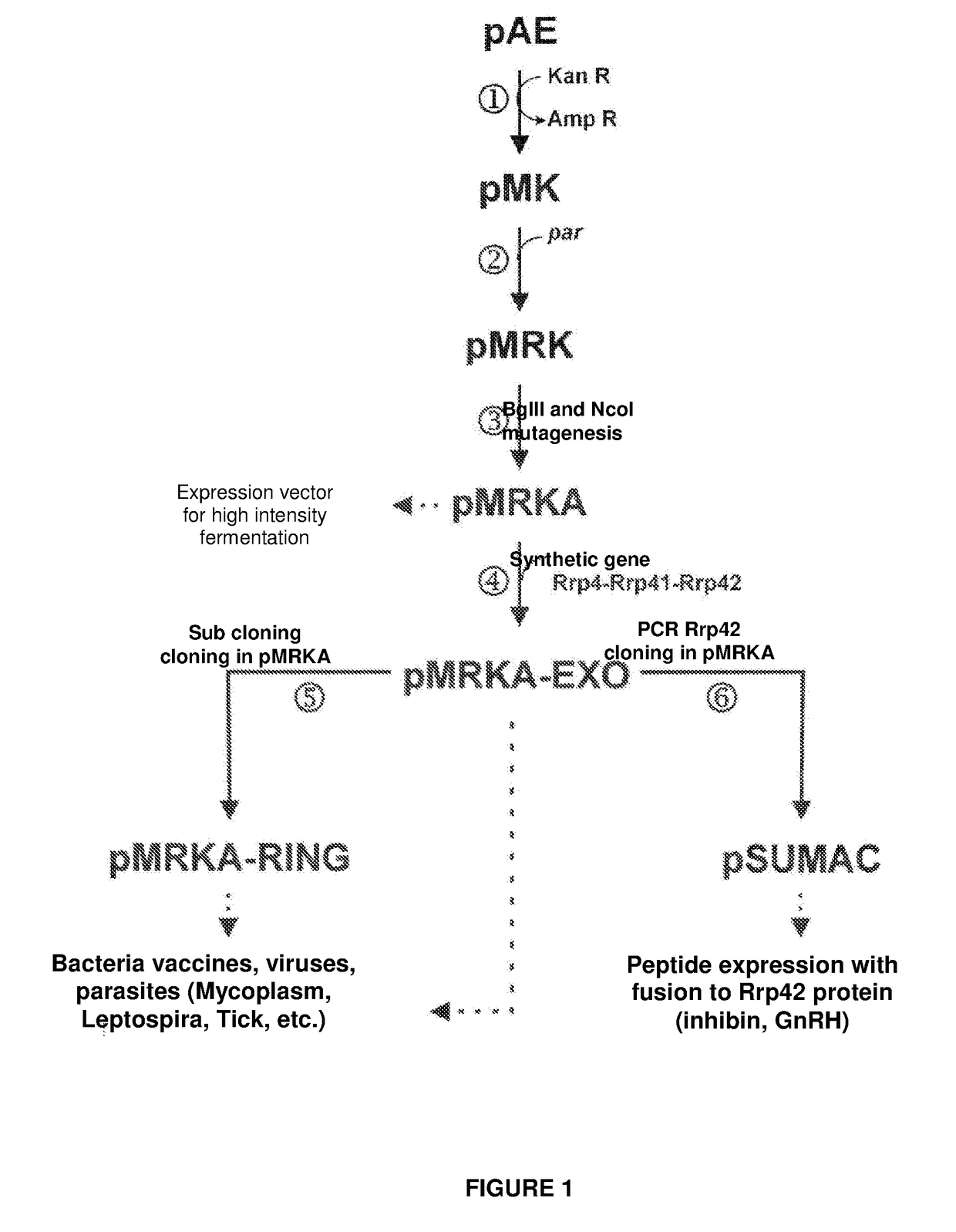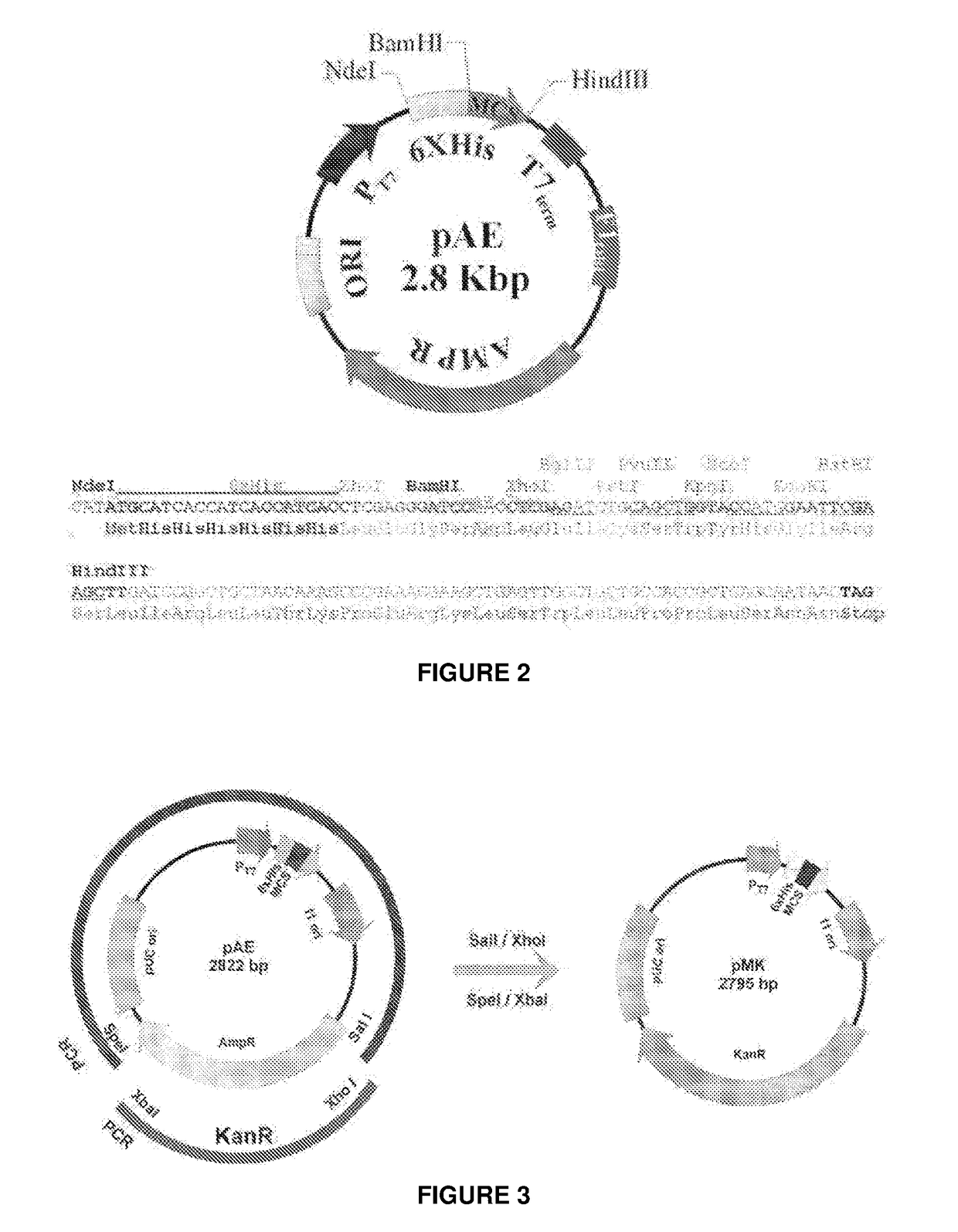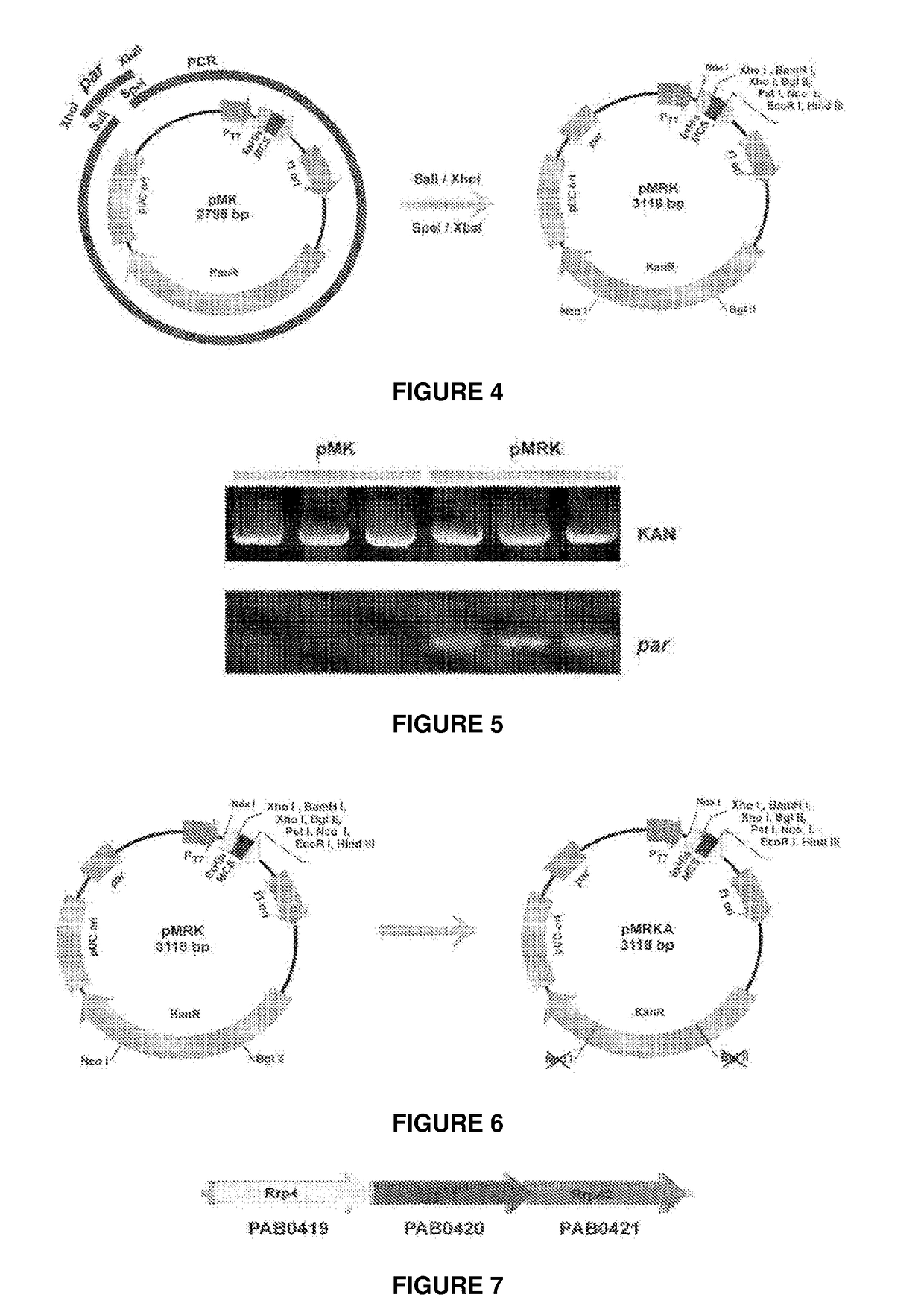Escherichia coli t7 expression vector, vectors for the co-expression and co-purification of recombinant peptides in/with carrier proteins, use of expression vectors for obtaining complexes with multiple antigens and immonomodulators
a technology of escherichia coli and t7, which is applied in the field of vectors for coexpression and copurification of recombinant peptides, can solve the problems of inability to obtain such antigens, inability to use markers, and inability to manufacture vaccines based on this type of antigens, etc., and achieves the effect of improving production
- Summary
- Abstract
- Description
- Claims
- Application Information
AI Technical Summary
Benefits of technology
Problems solved by technology
Method used
Image
Examples
example 1
[0134]Preparing the inoculum:
[0135]Unfreezing the aliquot of producer strain and inoculation in LB-kanamycin medium.
[0136]Subsequently, the mixture is cultured and stirred in Shaker, in 1L erlenmeyer with 200 ml of LB-KAN (25 pg / ml). Culture at 37° C., 200 rpm for 14-16 hours (DO600 nm from 1 to 2).
[0137]Fermentation:
[0138]The obtained culture in the previous step is transferred to a vat filled with 5 L of the medium complex high density (MCHD). After reaching DO600nm of 20, it is started the induction for feeding with Lactose, until complete for 22 hours of culture.
[0139]Cell Collection:
[0140]Cells are collected by centrifugation in 6000 rpm for 30 minutes, in temperature of 8° C. in 1 L bottles.
[0142]The cells are resuspended in buffer (5 ml per gram of pellet): 30 mM Tris-HCI pH 9,0; 0,1% Triton X-100;; 5 mM 2-mercaptoethanol.
[0143]Afterwards, the cells are treated for 1 hour at 90° C., in hot water bath, homogenizing after each ten minutes in Turrax homogenizer ...
example 2
Fusion of Z-Z Domains from A Protein of Staphylococcus aureus in Pyrococcus exosome Rrp42 Protein
[0153]The immunomodulatory activity of Z domain together with exosome protein complex, that in the present invention is used as antigen carrier, was verified by means of a gene synthesis (SEQ ID No: 41), that encodes an amino acid sequence through the expression, in tandem, of two Z-domain copies, herein named Z-Z domains (SEQ ID No: 42). The nucleotide sequence (SEQ ID N: 41) was in-fusion cloned in region corresponding to an Rrp42 protein N-terminal end, using Ncol and Sall sites in pMRKA-EXO and pMRKA-RING plasmids. FIGS. 18 and 19 present representative diagrams of this strategy, resulting in pMRKA-ZZ-EXO (SEQ ID No: 43) and pMRKA-ZZ-RING (SEQ ID No:45)) plasmids, respectively, and consequently in Rrp42 protein expression with Z-Z domain fusion in its N-terminal end (SEQ ID No: 44).
[0154]To verify if the ZZ domains fusion interferes with thermostability and purification of the comple...
example 3
Obtaining Protein Complexes Containing Mycoplasma hyopneumiae Antigens
[0157]Mycoplasma hyopneumoniae is one of the main pathogenic agents that affects pig breeding. Various vaccine candidates have already been identified, however, none of them, separately, can induce protection against disease in the same level as the commercial bacteria. Aiming to use the exosome complex to charge several antigens with Mycoplasma hypneumoniae, three chimeric proteins encoding genes were synthetized: 36-MHP271; P46-P97R1 R2 and HSP7O-NrdF, corresponding to vaccine antigen pairs. The synthetic genes were clone in pMRKA-EXO vector by BgIII-Kpnl; BamHl-EcoRl and XhoI-HindIII sites, respectively.
[0158]The resulting pMRKA-EXOMYC plasmid can express the following polyproteins:[0159]Rrp4-P36-MHP271 (80.5 kDa)[0160]Rrp41-P46-P97R1 R2 (82.7 kDa)[0161]Rrp42-HSP-NrdF (72.6 kDa).
[0162]In similar way, P46-P97R1 R2 and HSP7O-NrdF chimeric proteins genes were cloned in pMRKA-RING vector by BamHI-EcoRl and XhoI-Hin...
PUM
| Property | Measurement | Unit |
|---|---|---|
| pressure | aaaaa | aaaaa |
| temperature | aaaaa | aaaaa |
| temperature | aaaaa | aaaaa |
Abstract
Description
Claims
Application Information
 Login to View More
Login to View More - R&D
- Intellectual Property
- Life Sciences
- Materials
- Tech Scout
- Unparalleled Data Quality
- Higher Quality Content
- 60% Fewer Hallucinations
Browse by: Latest US Patents, China's latest patents, Technical Efficacy Thesaurus, Application Domain, Technology Topic, Popular Technical Reports.
© 2025 PatSnap. All rights reserved.Legal|Privacy policy|Modern Slavery Act Transparency Statement|Sitemap|About US| Contact US: help@patsnap.com



